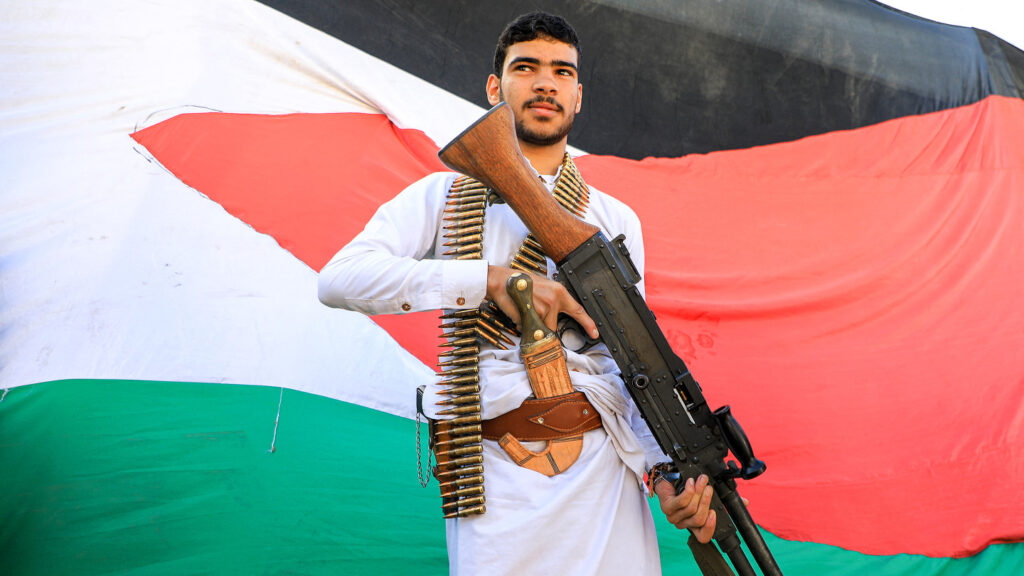
In a dramatic escalation, Israel last week launched a targeted airstrike that killed Ahmed al-Rahawi, the prime minister of the de facto Houthi regime in Sanaa.
The 28 August attack marks the most senior Ansar Allah figure killed in US-Israeli military operations to date, signalling a significant shift in strategy. Alongside Rahawi, several other high-ranking Houthi officials were killed or wounded.
Nearly two years into the simmering Israel-Houthi hostilities – triggered in the wake of the Gaza genocide – this latest move suggests a decisive turn: Israel is no longer merely degrading infrastructure but is now systematically targeting the leadership core of the Houthi movement, striking at the heart of its command structure.
Despite the blow to its political leadership, Ansar Allah’s military command – organised through a resilient and decentralised structure – remains largely unscathed. The group has vowed retaliation.
In a televised address two days after the Israeli strike, its leader Abdul-Malik al-Houthi declared: “There are those who chose submission, weakness, and silence in the face of the horrendous crimes committed by the Israeli enemy – the crime of the century against the Palestinian people. But our people, through their faith, their identity and their human conscience, have refused to stand idly by in the face of such atrocities.”
On 1 September, the Houthis claimed responsibility for a strike on the Scarlet Ray, an Israeli-owned, Liberian-flagged tanker operating in the Red Sea. In response, Israeli Prime Minister Benjamin Netanyahu warned that any attacks on Israeli territory or maritime assets would be met with force, vowing the Houthis would “pay a heavy price”.
The Houthis’ rising regional profile
The conflict appears to be settling into a protracted, low-intensity war of attrition – one unlikely to culminate in a decisive confrontation but instead marked by steady escalation and strategic signalling.
The Houthis have emerged as the sole Arab force consistently launching strikes on Israeli territory, a distinction that significantly elevates their standing both regionally and at home.
Within Iran’s ‘Axis of Resistance,’ this sustained campaign reinforces their credentials as a committed anti-Israel actor, placing them alongside Hezbollah and Iranian-backed militias in Iraq.
Domestically, it bolsters their image as defenders of the Palestinian cause, allowing the movement to rally public support and legitimise its rule in Sanaa amid deepening humanitarian and political crises. For Ansar Allah, continued confrontation with Israel is as much about geopolitical alignment as it is about consolidating internal authority.
Dr Andreas Krieg, associate professor at the Defence Studies Department at King’s College London, argues that even if the war in Gaza subsides, the Israel-Houthi conflict is likely to keep Ansar Allah locked into a confrontational stance.
“For Israel, the Red Sea has become a permanent security theatre, demanding resources it has historically reserved for Hezbollah and Gaza. Regionally, the continuation of this conflict risks institutionalising insecurity in the Red Sea in the way the Strait of Hormuz became synonymous with Iran’s coercive leverage,” he told The New Arab.
“If Houthi attacks and Israeli reprisals remain cyclical, shipping companies may permanently reroute away from Suez, reshaping global trade flows and hurting Egypt, the Gulf states, and Europe alike,” Dr Krieg added.
“The larger implication is the normalisation of irregular warfare at sea: a non-state actor demonstrating it can threaten a global trade artery for political leverage. That precedent will not be easily undone.”
Nick Brumfield, an independent Yemen researcher and host of a weekly Yemen news roundup, similarly assesses that hostilities between Israel and Ansar Allah are set to continue for perhaps a long time.
“Unless Israel is able to take out senior members of the Houthi inner circle, which the 28 August strikes did not do, I imagine [the Houthi-Israeli conflict is] going to follow the same trajectory it has been, with the Houthis continuing to launch missiles at Israel or an ever-expanding circle of international shipping, and Israel occasionally conducting shock-and-awe strikes on Sanaa and other high-visibility targets like the Port of Hodeidah,” he said in a TNA interview.
Yemen, the Middle East’s poorest country, has endured more than a decade of political fragmentation, violent conflict, and institutional collapse. Since the eruption of civil war in 2014, the country has become a battleground for regional rivalries, most notably between Iran and Saudi Arabia, further entrenching instability and eroding layers of governance.
“The Yemenis have managed to survive Saudi and Emirati punishing attacks for several years and, more recently US, UK, and Israeli air strikes. My guess is the Israeli attacks will not break their spirit and resolution,” Dr Gawdat Bahgat, a Distinguished Professor of National Security at the National Defence University, told TNA.
The humanitarian toll on Yemen
Yemen remains the site of one of the world’s gravest and most protracted humanitarian disasters – a crisis deepened by years of war, economic collapse, and international neglect.
Now, Israeli air strikes are compounding an already catastrophic situation. By targeting vital civilian infrastructure – including key ports, power stations, and the airport in Sanaa, the only functioning airport in northern Yemen, which served roughly 80 percent of the country’s population before its closure – Israel is not only undermining the delivery of essential aid but accelerating the collapse of basic services for millions.
These strikes, launched under the banner of military necessity, have severely disrupted humanitarian supply chains in a country where over 21 million people already rely on aid to survive.
Human rights experts warn that such actions constitute clear violations of international law. As the humanitarian space in Yemen continues to shrink, the civilian toll of the Israel-Houthi conflict is likely to grow – fuelling not only suffering on the ground but also broader regional instability.
“Israel has not learned from the failed Saudi-led intervention in Yemen but rather is continuing the same tactic: scorch the Earth,” Arwa Mokdad, a Yemen expert at the University of Oxford, explained to TNA.
“Instead of targeted strikes, Israel has been bombing key civilian infrastructure with devastating consequences for the local population and, less so, the Houthis,” she added.
Yet, as Dr Krieg observed, Ansar Allah is strategically positioned to capitalise on the deepening humanitarian crisis – marked by the spread of famine and disease across Yemen – by framing itself as the sole defender of the country against Israeli aggression.
“The humanitarian impact is not just about today’s shortages; it is about future irreversibility. Every crane destroyed at Hodeidah or fuel depot burned in Sanaa takes years and international consensus to rebuild, and Yemen does not have that time,” he told TNA.
“If the strikes persist, the country could drift into a permanent humanitarian emergency, where aid becomes a structural lifeline rather than a bridge to recovery. That makes Yemen less governable and more vulnerable to radicalisation – precisely the conditions the Houthis thrive in.”
By drawing the Houthis into direct confrontation, Israel has inadvertently elevated the group’s status from a domestic insurgency rooted in Yemen’s civil war to a symbolically potent member of the broader regional anti-Israel axis.
This transformation grants Ansar Allah a level of legitimacy and visibility it could never have attained through the internal Yemeni conflict alone.
Their positioning alongside more established actors like Lebanon’s Hezbollah and pro-Tehran factions in Iraq enhances the Houthi rebel movement’s appeal to potential recruits, bolsters the narrative of resistance that justifies ongoing Iranian support, and further consolidates their hold on northern Yemen.
At the same time, it places rival Yemeni factions – many of whom remain fragmented, externally backed, or politically stagnant – at a disadvantage, casting them as passive or compromised in the face of what the Houthis portray as a defining regional struggle. In this context, Israel’s military strategy risks empowering the very force it seeks to contain.
“Ironically, Israel is increasing Ansar Allah popularity both in Yemen and the region at large. The group was not on most people’s radar but is now perceived as one of the sole countries that stood with Palestine. This has resulted in an increase in recruitment within Yemen and popular sympathy abroad, which has bolstered the group’s confidence,” said Mokdad.
However, Dr Krieg warns that Ansar Allah faces the longer-term risk of overextension.
“Diverting resources to fight Israel while governing a collapsing Yemen exposes them to domestic resentment once the nationalist ‘rally around Palestine’ effect fades,” he explained in a TNA interview.
“If famine deepens and services vanish, Israel may not break the Houthis militarily, but time and internal dissent could. Thus, the paradox is that Israeli strikes are both empowering the Houthis politically and planting the seeds of potential fragility inside their movement.”
A prolonged, entrenched, and overlooked war
Ultimately, there is no compelling reason to expect Israel-Houthi hostilities to wrap up in the foreseeable future. This conflict between Tel Aviv and Ansar Allah is “morphing Yemen from a ‘forgotten war’ into a frontline of Middle Eastern geopolitics, with maritime security, humanitarian collapse, and regional power rivalries intertwined,” stated Dr Krieg.
“For the Houthis, this is a chance to project themselves as more than a local insurgency; for Israel, it is a new long war of defence on yet another front. For the region, the danger is that the Red Sea becomes a permanent grey zone of insecurity, with Yemen’s humanitarian tragedy as its enduring backdrop,” he added.
What emerges is more than another front in the ‘Arab-Israeli conflict’ but a dangerous feedback loop where military escalation reinforces political entrenchment and humanitarian collapse fuels further radicalisation.
With no diplomatic off-ramp in sight and international attention still sporadic, the Israel-Houthi conflict risks becoming a long-term fixture of regional instability – an open wound on the map of the Middle East.
These mounting costs go far beyond any battlefield, with millions of Yemenis continuing to suffer the consequences of a conflict that makes daily life all the more difficult to endure in a country ravaged by economic collapse, disease, famine, and poverty.
